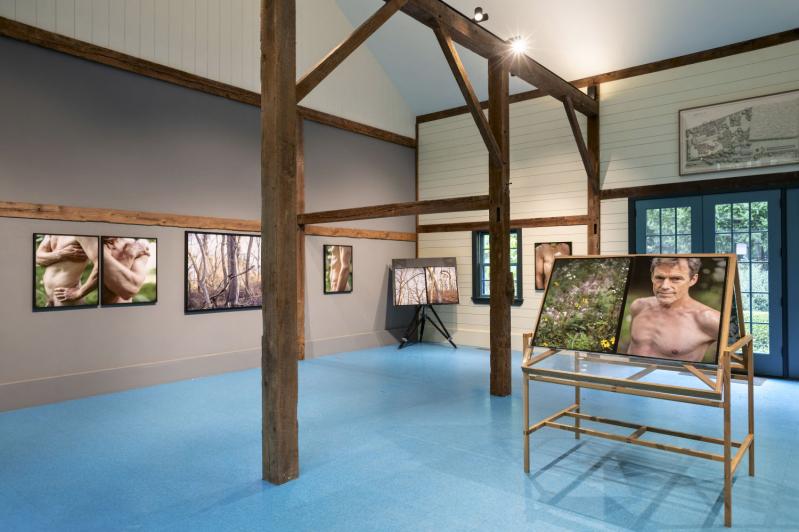Michael Light’s large-scale photographs in “Two of ‘Em,” the current exhibition at the Madoo Conservancy in Sagaponack, are arresting by themselves, but knowing how they are informed by Mr. Light’s deep and complex roots on the South Fork adds another dimension to the work.
He grew up in Amagansett, where his mother, Deborah Light, had purchased the 30 acres now known as Quail Hill when he was 4 years old. She was a friend of Robert Dash, the artist who founded Madoo, where she took Michael, then a 15-year-old budding photographer, for drinks and dinner one night, and he took some of his photos. Looking at them, Dash declared that the teenager had “a good eye.”
Eight years later, Mr. Light said during a phone call from San Francisco, he “headed out from the extraordinary youth I had on Long Island.” He has lived there ever since and has developed an acclaimed body of aerial photographs.
In 2016, a year after his mother died, he flew his 600-pound plane, whose top speed is 100 miles per hour, across the country — it took three days — and landed at the Montauk airstrip. While here, he made a number of photographs from the air, many of them taken above Gardiner’s Island, where he’d hunted as a boy.
An exhibition of those photos, “Gardiner’s Island and Amagansett,” was held at the Drawing Room in East Hampton in 2019. “Word got out,” as Mr. Light put it, and Madoo asked if he would exhibit there.
“They really wanted something local, and they did not want to show my western work. I viewed it as a great opportunity to try and bite into some of the complexities which are in my head as an artist.”
“Two of ‘Em” — an immersive installation consisting of three large photo books displayed in conversation with each other — is the result. One depicts summer nude photographs of an old friend; another, the vulnerable beech forests of Stony Hill and the decimated pitch pines of Napeague, and the third, images of the gardens at Madoo. Larger versions of prints in those books are framed and mounted on the walls. Mr. Light said they are the first serious photographs he has taken on the ground in decades.
“Madoo is not overtly classical,” he observed. “There are classical overtones, there are Italian references, and I wanted to insert the male body into Dash’s garden. But I didn’t actually have to take somebody to Madoo and ask them to take off their clothes.”
Instead, the summer nudes were shot in western Massachusetts, where their subject lives. “It was a very interesting moment in the long and varied friendship with this person, who shall remain nameless. When I asked if he was willing, he said, ‘If I’m not comfortable with my physical being now, I’m never going to be.’ “
Since the garden and the landscape are the elements that tie his three books together, Mr. Light explained, “I needed garden statuary, and I needed male garden statuary. I wanted to work with people over 60, where it’s more about affection than desire.”
The nude photographs alternate with shots of flowers and trees in the book titled “Twenty Four/Sixty Four/Massachusetts.” It opens with a photograph of Mr. Light’s friend at the age of 24, facing one of the shots of him today, at 64.
The book form is central to Mr. Light’s creative life. “Long ago, I started making large-format handmade books, and it’s
been the core of my production. So the books are the heart of the show, and a book form is very different than putting images on the wall. I can control the sequence. I can’t control the viewer going forward or backward, but they can’t see more than, in this case, two images at a time.”
There is no text in the books, nor are there instructions. At 29 by 44 inches, the photographs are scaled for the arc of the human arm. “One can’t really go much bigger with them, unless you are eight feet tall.”
Mr. Light said the Madoo book was the slightest of the three. “It’s kind of a light summer idyll when you have certain warm hazy days and you’re inside your garden, and it’s just summer, floaty, haze.”
The photographs of the diseased beech trees shot at Stony Hill and on Napeague were harder to make, he said, but ultimately more rewarding. “Quail Hill is the edge of Stony Hill and Amagansett agriculture. I grew up with all these beech trees, and I’m almost embarrassed to say how psychologically important they are to me. The nematode is tearing them to pieces.”
Anyone driving the Napeague stretch, or Route 114 between East Hampton and Sag Harbor, or in Northwest Woods, has seen what the Southern pine beetle has done to pitch pines. Mr. Light thinks some of his pitch-pine photographs are successful, but “I don’t think I got the biblical, almost fire-like aspect of all the pines dying in a year.”
In 2013, not long before Robert Dash died, Mr. Light visited him for the first time since the ‘80s. “I reminded him about his remark that I had a good eye, and he snorted back, ‘Not only one, but ya got two of ‘em.’ “
As Mr. Light was installing his work in what had been Dash’s studio, “I kept imagining Bob saying to me, from the afterlife, ‘Yeah, I knew you when you were 15, but what do you got for me now?’ ”
The answer is worth a trip to Madoo.
The exhibition will remain on view through Sept. 21. Madoo is open, by reservation on its website, Wednesday through Sunday, noon to 4 p.m.




